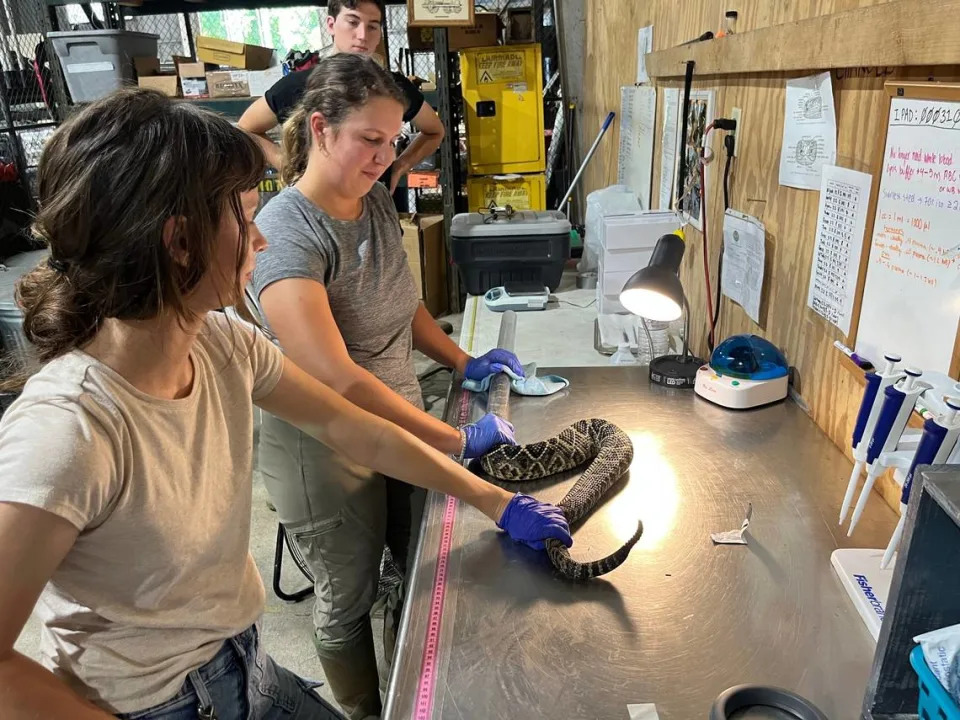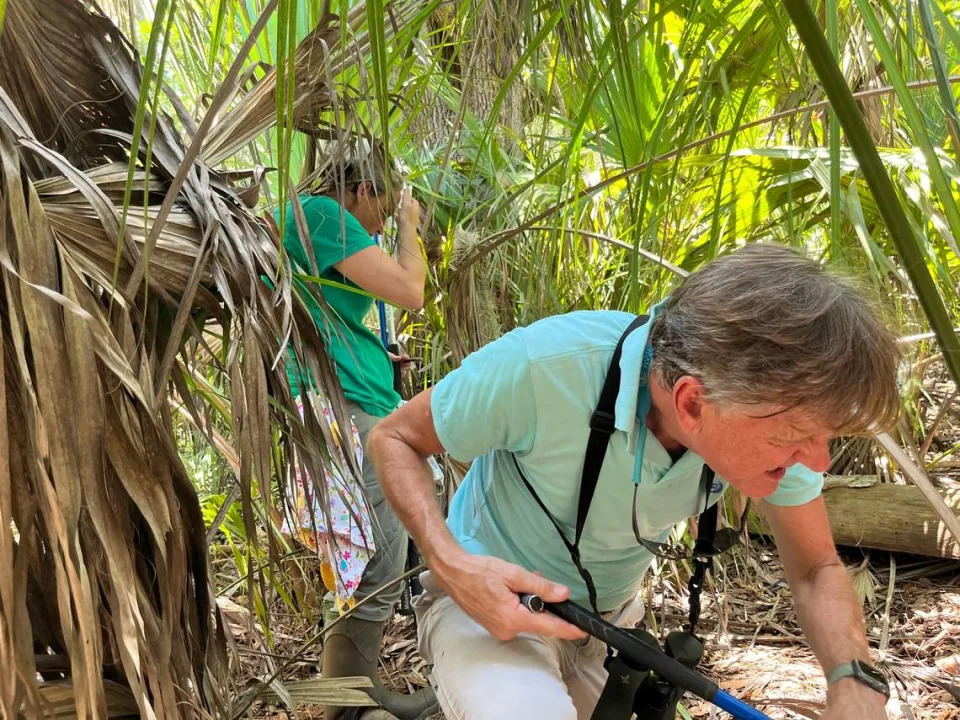Story says the largest one the researchs have caught i 15 feet long. thats a lot of Diamondback. ive seen them around 7 feet, and thats spooky but 15'?

Sat, August 19, 2023 at 4:00 AM CDT·6 min read
15
On Oct. 28, 2017, a 5-foot-long, 6-pound male eastern diamondback rattlesnake was found dead on a road on Hilton Head Island. It had been run over by a car. But how did this snake, which originated on Parris Island, the location of the U.S. Marine Corps Recruit Depot, make it more than 5 miles across the salty waters of Port Royal Sound to Hilton Head?
It turns out, researchers discovered later, that the plucky snake swam, undulating through the waves of the Broad River. It was the farthest migration of an eastern diamondback rattlesnake from its home range ever observed.
“They are the ultimate underdog,” Jayme Waldron says of eastern diamondbacks, because “very few people like rattlesnakes.”
Waldron, a professor of biological science at Marshall University in West Virginia and a snake expert, does. If you have eastern diamondbacks on your land, Waldron says, it shows you are managing the natural resources well, which she says should be taken as a badge of honor.
But the apex predator is struggling to hang on in the longleaf pine forests and coastal lowlands of southeastern United States, primarily because of habitat loss. It’s venom is also in high demand for use in research labs. There are no legal protections for the snake, which Waldron says is as much a symbol of the Lowcountry as the Palmetto tree.
“It’s sad,” Waldron says. “They should be way more widespread than they are.”

Emily Gray attempts to coax an eastern diamondback rattlesnake into a plastic tube so it can be safely handled as measurements are taken. A microchip also was inserted in the snake so it can be tracked over time.
Waldron and the U.S. Marines are fighting to save eastern diamondbacks and their habitat by learning more about the mysterious creatures.
The remarkable journey of the eastern diamondback to Hilton Head a few years ago is only known because of a microchip that was planted under its skin on Aug. 15, 2015 on Parris Island, two year’s prior to its death, as part of that study.
“Shrimpers have caught them for years in their shrimp nets offshore,” Holloway said in reference to the long dispersal of the Hilton Head rattler.
Still, while eastern diamondbacks are capable swimmers, the long excursion to Hilton Head was particularly notable because it was made over water — and by an older snake. It’s usually the younger ones that travel the farthest.
Eastern diamondbacks, known for their distinctive diamond-shaped skin patterns and large triangular-shaped heads, can live more than 20 years but population growth is slow because they only produce eggs every two to four years. They can be brown, yellow or tan with distinct black, brown and cream diamonds on their back and blend in brilliantly in the Lowcountry. The best way to detect them, Waldron advises, is to look for changes in texture, not color.
The oldest snake Parris Island researchers have captured is “Hussie,” so named because she “bred with a bunch of males,” Waldron says. The dame is older than most of the students who assist Waldron in the research. At the time of her capture 4 years ago, Hussie was over 15 feet long. Waldron calls her a “giant.”
The largest snake caught to date is Elijah, who was 9.5 pounds at capture.

Students prepare a captured eastern diamondback rattlesnake for tagging at U.S. Marine Corps Recruit Depot Paris Island.
The eastern diamondback rattlesnake population at Parris Island, while not known, is consider healthy. That’s why it’s an ideal place to study them.
Over 20-square-miles, the snakes ambush rats and rabbits and fox squirrels, injecting deadly venom through fangs up to three-fourths-of-an-inch-long. Home ranges are about 20 acres.
“They have everything they need,” Holloway says.
Over the 15 years of the study, Marine researchers and Marshall University students have captured more than 1,000 snakes and inserted microchips or attached transmitters to their rattles with glue and thread so they can track them.
The study has two purposes: Limit conflicts between Marine recruits and rattlesnakes — more than 20,000 recruits are trained at Parris Island annually — while gathering information on the snakes and their habitat. The information could prove vital in saving the imperiled pit viper, which is a candidate for listing under the Endangered Species Act. A decision from the U.S. Fish and Wildlife Service whether to protect it could come as soon as next year. In South Carolina, the eastern diamondback is listed only as a “species of concern,” which does not provide any legal protection.
Habitat protections are critical to the snake’s long-term survival, Holloway says.
“You can protect the animal,” says Holloway, “but really, you need to protect where it’s living.”
Longleaf pine once dominated the coastal plain blanketing more than 90 million acres from Texas to Virginia, according to the Nature Conservancy. Today there are just 5.2 million acres, up from an historical low of 3.2 million acres two decades ago.

Jayme Waldron and John Holloway search for an eastern diamondback rattlesnake at Marine Corps Recruit Depot Parris Island fitted with an electronic device that allows researchers to track its movements. The Marines and Marshall University are participating in tracking project of eastern diamondbacks to learn more about them and their habitat.More
Military bases that have not been as developed and have less public access can be a “last resort” for species that are in decline because of development pressures, Holloway says.
The snakes not only keep rodent populations under control, Holloway says, but also reduce the numbers of ticks because they eat mammals that the blood suckers feed on.
While most people try to avoid the snakes, Waldron and her students march through the marshlands and thick forests clogged with palmetto and pine trees at Parris Island looking for them in logs, under trees and in holes.
World’s biggest rattlesnakes can swim from Parris Island to Hilton Head
Karl PuckettSat, August 19, 2023 at 4:00 AM CDT·6 min read
15
On Oct. 28, 2017, a 5-foot-long, 6-pound male eastern diamondback rattlesnake was found dead on a road on Hilton Head Island. It had been run over by a car. But how did this snake, which originated on Parris Island, the location of the U.S. Marine Corps Recruit Depot, make it more than 5 miles across the salty waters of Port Royal Sound to Hilton Head?
It turns out, researchers discovered later, that the plucky snake swam, undulating through the waves of the Broad River. It was the farthest migration of an eastern diamondback rattlesnake from its home range ever observed.
“They are the ultimate underdog,” Jayme Waldron says of eastern diamondbacks, because “very few people like rattlesnakes.”
Waldron, a professor of biological science at Marshall University in West Virginia and a snake expert, does. If you have eastern diamondbacks on your land, Waldron says, it shows you are managing the natural resources well, which she says should be taken as a badge of honor.
But the apex predator is struggling to hang on in the longleaf pine forests and coastal lowlands of southeastern United States, primarily because of habitat loss. It’s venom is also in high demand for use in research labs. There are no legal protections for the snake, which Waldron says is as much a symbol of the Lowcountry as the Palmetto tree.
“It’s sad,” Waldron says. “They should be way more widespread than they are.”

Emily Gray attempts to coax an eastern diamondback rattlesnake into a plastic tube so it can be safely handled as measurements are taken. A microchip also was inserted in the snake so it can be tracked over time.
Waldron and the U.S. Marines are fighting to save eastern diamondbacks and their habitat by learning more about the mysterious creatures.
‘Shrimpers have caught them’
John Holloway, the civilian natural resources manager at U.S. Marine Corps Recruit Depot Parris Island, and Waldron and have been tracking the wanderings of eastern diamondbacks on Parris Island — and off of it — since 2008 in what has become the longest-running tracking project of the largest and most venomous rattlesnake in the United States.The remarkable journey of the eastern diamondback to Hilton Head a few years ago is only known because of a microchip that was planted under its skin on Aug. 15, 2015 on Parris Island, two year’s prior to its death, as part of that study.
“Shrimpers have caught them for years in their shrimp nets offshore,” Holloway said in reference to the long dispersal of the Hilton Head rattler.
Still, while eastern diamondbacks are capable swimmers, the long excursion to Hilton Head was particularly notable because it was made over water — and by an older snake. It’s usually the younger ones that travel the farthest.
Eastern diamondbacks, known for their distinctive diamond-shaped skin patterns and large triangular-shaped heads, can live more than 20 years but population growth is slow because they only produce eggs every two to four years. They can be brown, yellow or tan with distinct black, brown and cream diamonds on their back and blend in brilliantly in the Lowcountry. The best way to detect them, Waldron advises, is to look for changes in texture, not color.
The oldest snake Parris Island researchers have captured is “Hussie,” so named because she “bred with a bunch of males,” Waldron says. The dame is older than most of the students who assist Waldron in the research. At the time of her capture 4 years ago, Hussie was over 15 feet long. Waldron calls her a “giant.”
The largest snake caught to date is Elijah, who was 9.5 pounds at capture.

Students prepare a captured eastern diamondback rattlesnake for tagging at U.S. Marine Corps Recruit Depot Paris Island.
The eastern diamondback rattlesnake population at Parris Island, while not known, is consider healthy. That’s why it’s an ideal place to study them.
Over 20-square-miles, the snakes ambush rats and rabbits and fox squirrels, injecting deadly venom through fangs up to three-fourths-of-an-inch-long. Home ranges are about 20 acres.
“They have everything they need,” Holloway says.
Are protections coming?
Occasionally, they put a scare into a Marine recruit training in the toolies, but they rarely bite people, preferring to flee if they can. “They are not a very bitey snake,” Waldron says.Over the 15 years of the study, Marine researchers and Marshall University students have captured more than 1,000 snakes and inserted microchips or attached transmitters to their rattles with glue and thread so they can track them.
The study has two purposes: Limit conflicts between Marine recruits and rattlesnakes — more than 20,000 recruits are trained at Parris Island annually — while gathering information on the snakes and their habitat. The information could prove vital in saving the imperiled pit viper, which is a candidate for listing under the Endangered Species Act. A decision from the U.S. Fish and Wildlife Service whether to protect it could come as soon as next year. In South Carolina, the eastern diamondback is listed only as a “species of concern,” which does not provide any legal protection.
Habitat protections are critical to the snake’s long-term survival, Holloway says.
“You can protect the animal,” says Holloway, “but really, you need to protect where it’s living.”
Longleaf pine once dominated the coastal plain blanketing more than 90 million acres from Texas to Virginia, according to the Nature Conservancy. Today there are just 5.2 million acres, up from an historical low of 3.2 million acres two decades ago.

Jayme Waldron and John Holloway search for an eastern diamondback rattlesnake at Marine Corps Recruit Depot Parris Island fitted with an electronic device that allows researchers to track its movements. The Marines and Marshall University are participating in tracking project of eastern diamondbacks to learn more about them and their habitat.More
Military bases that have not been as developed and have less public access can be a “last resort” for species that are in decline because of development pressures, Holloway says.
The snakes not only keep rodent populations under control, Holloway says, but also reduce the numbers of ticks because they eat mammals that the blood suckers feed on.
While most people try to avoid the snakes, Waldron and her students march through the marshlands and thick forests clogged with palmetto and pine trees at Parris Island looking for them in logs, under trees and in holes.


